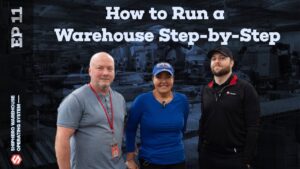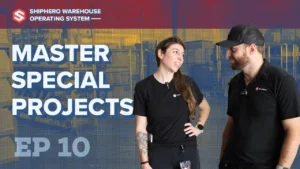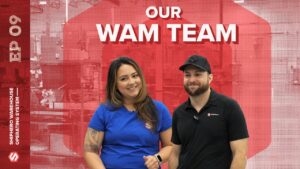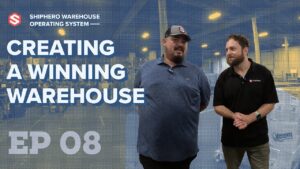Video Transcript
0:06
Speaker: Hello everyone and welcome to another episode of ShipHero Feature Walkthroughs. I'm joined today, as usual, by Yosef, our ShipHero VP of Product. How are you today, Yosef?
Yosef: Yeah, doing good. How are you doing?
Speaker: Pretty good. So today, Yosef will walk us through an amazing ShipHero feature called kits.
[Music]
0:37
Yosef: Sure. So kits, sometimes referred to as bundles or sets, are basically a way to group products together so that it may be ordered as one product, but when it goes to ship, there might be multiple products that are shipped. A common example would be like a two-pack of a product. So maybe you're selling a product that comes with a two-pack, maybe like a variety pack. ShipHero makes it really easy to create and manage that. In ShipHero, you can create a product and then define what the components of that product are. And as you'll see, the components could be multiple quantities of one product, several different products, or a combination of the two. I have some examples; we could pull up my screen and show you what that looks like.
1:52
Yosef: As you can see here, we have a product, it's a 10-pack of Oreo cookies. Now, I wanted to show this product to point out that one thing, and that is, in this case, as you can see, this is a 10-pack of the Stay Fresh packs of Oreos. This would not be a kit. So, the reason it's not a kit is because it's one unit. So, you go to the store or you go to ship it, you're just picking up that box. You may have 10 individual units in there, but those individual units are never sold separately. So, this, while it may sound like a kit, at the 10-pack, we would not define that as a kit; it's just a regular product that gets shipped. Another one might be a situation where I have three different components in the kit. So here, I have a chip sampler. So if you see, I have one Fritos, a Doritos, and a Lays. If I go down to my components, you'll see I have each one of those defined as a component of the kit. In this case, the quantity is one, it could be different, it doesn't have to be one. Again, it can be a combination of different quantities and different products. And you'll see we also keep track of how many are available of this kit.
As I mentioned before, in this case, there's one. And if you look at why, I have seven on hand of this, six on hand of this, and two on hand of that. But there's some allocated as well. So in this case, this bottom product, the Lays, I have two on hand, but one's allocated to an existing order. That means they only have one Lays available to ship. So the availability of the kit is just one. So again, that's tracked automatically, calculated automatically by ShipHero. Another thing to know about kits is the type of kit it is. So in ShipHero, there are two different types of kits that we have.
There's the standard kit, which I've been showing you, and what we call a build kit. And a build kit, you can see here I have my chocolate sampler. It looks very similar to any other kit, but you'll see this is defined as a build kit. And then I can easily change just by going to the product details and checking or unchecking this box. And the difference for that is at what point do we split up the kit when the order comes in? So for a standard kit, when an order comes in, the components are not changed, or the order line items are not changed until the order is actually being picked. So if you go into the order, and you can see I have an example order here, this is my chip sampler. So you can see what the components are. Each one of these products is a component, as we saw before, and this is how the product, the order looks throughout the entire order lifecycle.
When the picker goes to pick the order, they'll see the individual components. For a build kit, my chocolate sampler build kit, you can see that the actual components are split up and added as separate line items on the order. So you can see the actual chocolate sampler product has the status of "broken sets", and the individual products were added to the order. Now, the functional difference is twofold. First of all, if I change a kit component, if it's a build kit, any existing orders will not be affected. So if I go into my chocolate sampler and change this Hershey's milk chocolate bar to some other chocolate bar, this order will not be affected because the order has already been split up and the items have already been added to the order. In this case, if I go to my chip sampler and change out one of those components, this order would be changed, and that's because it has not been split yet.
So as long as I haven't started picking this order, I haven't shipped it, obviously, what the picker is going to see will be changed by the change to the component. Again, as long as it's not a build kit. Another use case would be if I need to split the order. So if I want to partially ship an order or if I'm shipping with different warehouses, it needs to be a build kit. Because these are split up and they're separate products on the order, I can now do that. If I was again shipping with different warehouses or partially shipping an order, I can now do that because these are separate products on the order. For a standard kit, I can't do that.
So if one of these items is not available, I can't ship the order, I cannot partially ship a kit. Because it's still kind of as one product, I want to split warehouses, again, I can't do that for a regular kit. So it needs to be a build kit. Most use cases we see, the regular standard kit is fine, but keep that in mind for those use cases that are mentioned where build kit may make more sense. Now, changing a kit between a build kit and a standard kit, that's really should not be done unless there's no order that needs to ship. Because the difference in when the product gets split up, you know, when those items get added to the order, we don't recommend making those any changes while there's existing orders for that product.
So if we do need to change it, just make sure any existing orders are shipped, then you can change it, and then any future order will use the new type. And keep in mind that any changes to inventory on any component will affect any kit. And of course, you can have one product, one component in multiple kits, and if I sell one kit, that'll affect the inventory of all the kits. Another thing to keep in mind is that kits are not warehouse-specific. So if I define a kit, that's going to be the same definition for all warehouses. So if you have products in multiple warehouses, those kits are going to be the same in all warehouses.
10:00
[Music]
10:46
Speaker: Awesome. Yeah, it's a really simple but yet useful and flexible feature, right?
Yosef: Absolutely. And we have some customers that use it in hundreds or even thousands of products. They're selling different bundles, different packs. And so it does become very useful.
Speaker: Great. Thank you very much, Yosef, for that explanation.
Yosef: A pleasure. And if you'd like to check out other feature walkthroughs, click on the top right corner. And if you're ready to unlock your eCommerce fulfillment superpowers, visit ShipHero.com to schedule a call with us. Thank you for watching. Have a great day.
[Music]



